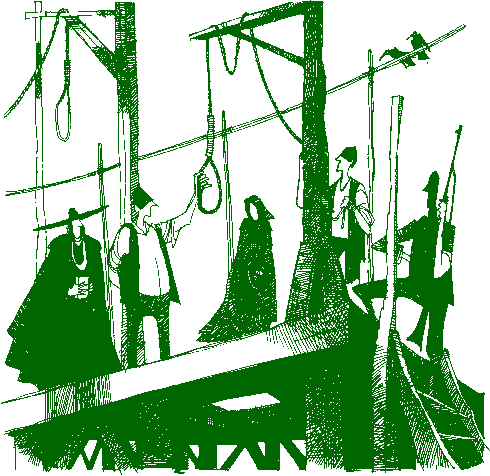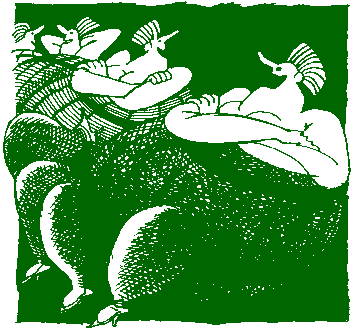Glen Moray
A Classic from Elgin
Richard Gordon renews some old acquaintances
"Tell me about the skulls Edwin." Truth be told, Ijumped at the chance to renew my acquaintance with the Glen MorayDistillery, not just so that I could hear Edwin tell this storyagain, but also so that I could visit my 'fat ladies'. But, moreof my dear friends later.
It had been a few years since I had visited the distillery butEdwin Dodson, the Distillery Manager since 1974, hadn't changed;indeed very little seemed to have changed since I took on therole of developing the market for Glen Moray many years ago.
 The Glen Moray Distillery will celebrateits first centenary in September of this year; 100 years as alegal distillery and many years before that as a brewery in atown that was once home to over 80 brewers. Before the Union,Elgin was very much the capital of the North, its wealth fuelledthrough extensive trade with the Baltic states, not least in beerand aqua vitae. The brewing is a natural result of the abundanceof the surrounding area, the Laich of Moray, also known as the"granary of Scotland". The Laich, the seaboard plainalong the Moray Firth, boasts a mild, even climate producingplentiful harvests and gives rise to the saying that "Morayhas forty days more summer than any other part of Scotland".Well it wasn't true for my visit. It was chucking it down. Evenso, for an area that lies within the 58th degree North Latitude,a little north of Moscow, it could have been much worse.
The Glen Moray Distillery will celebrateits first centenary in September of this year; 100 years as alegal distillery and many years before that as a brewery in atown that was once home to over 80 brewers. Before the Union,Elgin was very much the capital of the North, its wealth fuelledthrough extensive trade with the Baltic states, not least in beerand aqua vitae. The brewing is a natural result of the abundanceof the surrounding area, the Laich of Moray, also known as the"granary of Scotland". The Laich, the seaboard plainalong the Moray Firth, boasts a mild, even climate producingplentiful harvests and gives rise to the saying that "Morayhas forty days more summer than any other part of Scotland".Well it wasn't true for my visit. It was chucking it down. Evenso, for an area that lies within the 58th degree North Latitude,a little north of Moscow, it could have been much worse.
The distillery and its grounds are steeped in history. The oldroad into Elgin passes right through the distillery grounds,which have been witness through the centuries to the ebb and flowof the nation's legends, triumphs and disasters. What a litany ofnames: St Columba, Edward the First, the "Hammer of theScots", the Wolf of Badenoch who burnt down the city'scathedral. Macbeth, High Steward of Moray, later King of Scotlandpursued the wounded Duncan to his death in Elgin. Prince Charlesretreated this way to Culloden Moor followed by 'Butcher'Cumberland and the Hanoverian forces.
If no longer the capital of the world, then Elgin certainlylays claim to be its malt whisky capital. The spirit from theGlen Moray distillery is a classic example of the area. Light,fragrant, complex and estery, it extols the virtues of Speysidedistilling. Glen Moray can normally be found, in rather elegantblue packaging, at both 12 and 16 years of age.
As you sweep in from the Inverness road you will see thelow-roofed, traditional, warehouses (home to 50,000 casks) andthe large black 1960s grain store (soon to be refurbished) thatbelies the distillery's rather attractive character. Finding thedistillery is another matter and many may not be aware of itsexistence, tucked away in a little hollow behind a residentialarea in the town.
Glen Moray has a small and attractive central courtyard fromwhich we started our tour. The distillery is very compact andmakes best use of the original brewery buildings. We started withthe grist mill which was in full flight. Dod Grant, who startedwork at Glen Moray before I was even born, was taking samples ofthe grist. A stillman by trade, he was learning the arts of themashman, as part of Edwins's move to give the staff a wider rangeof skills. Dod is one of four stillmen who have a combinedexperience of 122 years. He still has a few years to go beforehis retirement which, being on the 1st of January 2000, should bequite a party.
We moved up to the mash room and the single stainless steelmash tun where the first water had just been added to the grist.A beautiful, sweet smell of warm, malty porridge hung in the air.This would be one of 14 mashes that week. The water for the mashcomes from a well whose waters originally flowed off the DhuMoor. The malt itself is lightly smoky but, interestingly, thewater can add additional peat notes to the final spirit.
In the tight space, we moved along to the five stainless steelwash backs. The smell reminded me of my early days of homebrewing. "This one is going well" said Edwin. And, soit was as I got the salutary CO2 kick in the head when I got tooclose to the opening of the washback. I never learn.
As we walked through to the still room Edwin told me how hehad recently been invited out to the US to help a bourbondistiller recreate the pot-still bourbons of old. Early recordsof distilling in the US are very hard to find so Edwin'sexpertise was asked for as they fired up their new pot still. Itwas in 1789 that the Reverend Elijah Craig, also a Scotsman,distilled the first bourbon whisky in America. History repeatingitself again.
In the still room, the stills were coming to the end of a run.The two wash stills were fat and onion-shaped, the spirit stills,similar in shape but smaller and more elegant. In the corner, theoriginal man-doors to the stills had been kept with 1897 markedclearly in the heavy gun metal. These doors used to be proppedopen with a stick so that people could lean in to clean thestill. Given their weight, I would not have liked to have had myneck in there if the stick had moved. The stills were off spiritand just a trickle was passing through the two gleaming spiritsafes. Over a year these safes see around 1.85m litres of alcoholpass through their glasses.
As we walked to the bonds, it was a chance to hear that storyagain. For Warehouse No 1 sits in the shadow of Gallow CrookHill, once the place of work for the city's two executioners.Here murderers, thieves and witches were "brint to thedeath, hanged by the craig, or droont" as fancy mightdictate. Records show that the bodies of those executed wereallowed to hang from the gallows until they fell down piecemealor were removed to make way for succeeding unfortunates. Thesecharming activities carried on to the late 17th Century, thoughremains of the gibbet were still to be seen in the 20th Century.
Warehouse No 1 used to be three feet lower than present andprone to flooding. In the early 1960s it was decided to raise thelevel using infill from the hill above. As workmen dug up thehill they found seven skulls. Cleaned up, the skulls became aninteresting addition to the still room. David Mathieson whoretired in 1975 was the Brewer at the time. Examining one skullhe found a hole in the back of the head, behind the ear and alead ball embedded in the jaw. Perhaps the master hangman had tofinish off a botched hanging by his latest apprentice. Takingpity on the skull, David Mathieson felt that the man would enjoya little outing. So, carefully placed on the dashboard, he tookhim on his first ever car journey round Elgin to show him howthings had changed. It certainly beats a nodding dog in the backof the car! I am glad to say however, that when the work finishedon the warehouse the skulls were safely reburied.
 Edwin was finishing his story as thedoor to Warehouse No 1 swung open and the cold, damp air, heavywith oak and spirit greeted us. The floor was earthen, theceiling low, the casks stacked three high. A traditionalwarehouse is regarded as best for maturing whisky, with itsclose, dark atmosphere providing the right balance for theinteraction of air, oak and spirit. This was a perfect example.
Edwin was finishing his story as thedoor to Warehouse No 1 swung open and the cold, damp air, heavywith oak and spirit greeted us. The floor was earthen, theceiling low, the casks stacked three high. A traditionalwarehouse is regarded as best for maturing whisky, with itsclose, dark atmosphere providing the right balance for theinteraction of air, oak and spirit. This was a perfect example.
And there they were, tucked away in a dark corner, my four'fat ladies'. In the semidarkness, I went up to stroke thosebeautiful curves, those gently rising bellies. Yes, they weresleeping beautifully. Last year, a number of magnificent sherrycasks were very carefully selected in Spain for the Society. Wesent some up to Glen Moray for filling with new spirit. Largereven than sherry butts, these 'fat ladies' or Gordas, to use thecorrect term, hold 600 litres, enough whisky to keep our membersquiet for a while. The only sad part of my visit was theknowledge that we will all be a lot older before these ladies ofthe dark reveal their secrets to us.
If you have comments about thissite, please contact the webmaster. Unless otherwise noted, all information in this siteŠ The Scotch Malt Whisky Society, Edinburgh, Scotland, 1997.
 The Glen Moray Distillery will celebrateits first centenary in September of this year; 100 years as alegal distillery and many years before that as a brewery in atown that was once home to over 80 brewers. Before the Union,Elgin was very much the capital of the North, its wealth fuelledthrough extensive trade with the Baltic states, not least in beerand aqua vitae. The brewing is a natural result of the abundanceof the surrounding area, the Laich of Moray, also known as the"granary of Scotland". The Laich, the seaboard plainalong the Moray Firth, boasts a mild, even climate producingplentiful harvests and gives rise to the saying that "Morayhas forty days more summer than any other part of Scotland".Well it wasn't true for my visit. It was chucking it down. Evenso, for an area that lies within the 58th degree North Latitude,a little north of Moscow, it could have been much worse.
The Glen Moray Distillery will celebrateits first centenary in September of this year; 100 years as alegal distillery and many years before that as a brewery in atown that was once home to over 80 brewers. Before the Union,Elgin was very much the capital of the North, its wealth fuelledthrough extensive trade with the Baltic states, not least in beerand aqua vitae. The brewing is a natural result of the abundanceof the surrounding area, the Laich of Moray, also known as the"granary of Scotland". The Laich, the seaboard plainalong the Moray Firth, boasts a mild, even climate producingplentiful harvests and gives rise to the saying that "Morayhas forty days more summer than any other part of Scotland".Well it wasn't true for my visit. It was chucking it down. Evenso, for an area that lies within the 58th degree North Latitude,a little north of Moscow, it could have been much worse. Edwin was finishing his story as thedoor to Warehouse No 1 swung open and the cold, damp air, heavywith oak and spirit greeted us. The floor was earthen, theceiling low, the casks stacked three high. A traditionalwarehouse is regarded as best for maturing whisky, with itsclose, dark atmosphere providing the right balance for theinteraction of air, oak and spirit. This was a perfect example.
Edwin was finishing his story as thedoor to Warehouse No 1 swung open and the cold, damp air, heavywith oak and spirit greeted us. The floor was earthen, theceiling low, the casks stacked three high. A traditionalwarehouse is regarded as best for maturing whisky, with itsclose, dark atmosphere providing the right balance for theinteraction of air, oak and spirit. This was a perfect example.